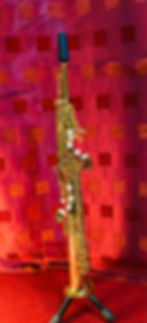
Best type of sax for beginners, a musician's opinion
2
9
0
Are you thinking about starting the saxophone but don’t know where to start? With a variety of saxophones available, each with its unique characteristics and charms, making the right choice can feel overwhelming. Whether you're a young student, an enthusiastic teen, or an adult rekindling a passion for music, finding the right saxophone is crucial to your musical success and enjoyment.
On this page, you will be guided through the different types of saxophones, weighing their pros and cons to help you make an informed decision. By the end of this post, you'll have a clearer understanding of which saxophone aligns best with your physical comfort, musical aspirations, and budget. So, let’s dive in and find the perfect saxophone for you!
1. Alto saxophone
Pros
The alto is most recommended for beginners
It is smaller and lighter than the tenor saxophone so is suitable for younger musicians
It can be used for many musical genres including jazz, pop and classical
Cheaper than tenor and baritone
Can be used in a school band
Cons
May be challenging for very young players with small hands
May be uncomfortable for older and larger players
2. Tenor saxophone
Pros
Larger than alto which may be easier and more comfortable to play for older musicians
Popular in jazz and rock music.
Can be used in school bands.
Cons
Size and weight is a challenge for younger musicians
Generally more expensive than the alto
3. Soprano saxophone (uncommon starting point)
Pros
Smaller than alto so very young players can start
Cheapest of the four saxophones on this list
Cons
Intonation and embouchure may be challenging for beginners
Small size may be uncomfortable for larger players
Harder to fit in a school band
Personal experience
I started the saxophone when I was around five or six years old on a cheap curved SMS Academy soprano saxophone. A curved soprano is much easier to hold and doesn't project outwards like straight sopranos, and is very light. My first teacher required a lot of persuasion because she thought that at that age one should start on recorder or clarinet and move to alto sax later. My hands were so small I had the D, E, and F side keys removed to fit around it. I personally do not see any problems starting down this route as training myself to perfect the intonation on soprano from a young age made it easier to move on to alto, my main sax now. And this approach proved popular: many other students also took it up within a year of me playing at primary school!
Recommendations
For children up to 12 years of age an alto sax is recommended. However, if this is too large and you're determined to play sax rather than clarinet you could order a curved soprano: your ears may not thank you for the first few months but with a supportive teacher you'll get there.
For teens and adults: Alto or tenor sax. This will depend on comfort due to size differences and which sound you prefer but alto is recommended as not as much air is needed. Keep in mind that altos are less expensive. A good, supportive strap is key for comfort with the heavier instruments.
Try them out
Visit music stores or rent saxes. This hands-on experience provides you with knowledge and preferences towards your sax of choice. You can also consult teachers and band leaders for more personal advice.









